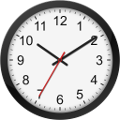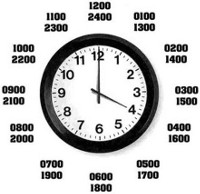|
Why Is It That Military Time Is Different? Many wall clocks in American homes, schools, and businesses display the numbers 1–12. This is the same for many wristwatches. When telling time using these devices, people say numbers and then include the designator a.m. or p.m. (ante meridian or post meridian), depending on whether the time is before noon or after noon. This kind of timekeeping is done in a few other countries as well. However, most countries around the world—and, indeed the U.S. Military (and other military organizations)—use a 24-hour clock. 
We already divide the day into 24 hours, each lasting 60 minutes, each of those lasting 60 seconds. Non-digital wall clocks have an hour hand, a minute hand, and a second hand. Digital wall clocks display the time by hour and minute(s) and sometimes include second(s). Some digital wall clocks display time on a scale of 0–24. This is true of many digital wristwatches as well. Telling time using all 24 hours leads to what to some people would say as 1:00 p.m. being, to other people, 13:00. In the same way, 5:24 p.m. would be displayed, in the 24-hour time system, as 17:24 (because the numbers don't reset after 12 but continue on until midnight, which is usually 0 and not 24). The difference isn't noticeable for time before noon because 7:00 a.m. is referred to as 7:00. The U.S. Military uses the 24-hour time system. Many Americans refer to this as Military Time. Military Time has a few further differences:

The U.S. Navy was the first branch of the U.S. Military to adopt a 24-hour time system, doing so in 1920. The U.S. Army followed suit but not until 1942. The U.S. Military briefly used the 24-hour time system during World War I. Many other countries around the world use the 24-hour time system (but not the full Military Time treatment). The U.S. and Canada still officially use the 12-hour time system, as does the United Kingdom, although many transportation systems and broadcast entities in the U.K. use the 24-hour time system. Have a suggestion for this feature? Email Dave. |
Social Studies for Kids |





